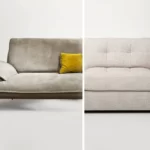First, how to steam clean a couch?
Pretreatment of stains is crucial in the preparation process before cleaning the sofa. Other important steps include starting with the cushions, steam cleaning the rest of the sofa or chair, treating stubborn stains, and letting the couch dry.
Even though a furniture steam cleaner may appear to be a miracle device in some ways, if you take your time and pay attention to details both before and during upholstery cleaning, you’ll get better and more thorough results.
Continue reading so I can give you more specific instructions on how to steam clean a couch.
Table of Contents
How To Steam Clean A Couch?
Preparation Before Cleaning Your Couch
Check the washing instructions label on the couch before you consider this treatment. Make sure it says it can withstand being steamed. Water-safe furniture doesn’t have an “x” on it, so it shouldn’t have any on this item either. Furniture with the SW label is safe around water and solvents.
Basically, if your couch has an “x” on it, it cannot withstand being steam conditioned. Reading the label on your couch is the best way to determine whether it is safe to steam.
Before you begin steaming, you might have to take some cushions out. This will lessen the chance of the padding and fabric being harmed.
A cleaner you hire should be informed that you want your couch steam cleaned. But it’s important to remember that lots of cleaners use solvents when they clean.
These cleaners are very potent and might permanently harm your upholstery. Aim to find out what chemicals the company uses when you call. They might use substances like bleach, which can harm your couch.
Affiliate links are used below. We take part in the Amazon Services LLC Associates Program, an affiliate marketing scheme created to give us a way to make money by linking to Amazon.com and associated websites.
Pre-treating Stains Is Essential
If you discover that your couch has numerous stains, try pre-treating them before steam cleaning. You’ll end up saving time and money if you do this.
You can accomplish this by using a sponge that has been dipped in rubbing alcohol. Alternatively, you can apply baby powder to stains with a damp cloth because it absorbs moisture and helps stop subsequent staining.
As an alternative, you can treat pet hair stains with lemon juice. The removal of fur is made simpler by the softening effect of lemon juice. Do you enjoy the occasional coffee spill? The truth is that you can treat coffee stains with hydrogen peroxide.
Coffee’s caffeine is broken down by hydrogen peroxide. To eliminate coffee stains, dab a cotton swab in hydrogen peroxide. In addition, you may discover that using a toothbrush can really aid you in removing those difficult stains.
In conclusion, the results of a steam clean will be significantly improved by applying touch materials to all those nasty, dark stains first.
Use The Proper Attachments For Different Applications
Many steam cleaning attachments are included with the Volt Electra. You should check your manual to make sure you are using the right one for the type of fabric or another surface you are cleaning. Your furniture may be harmed if the wrong steam cleaner attachment is used for the sofa.
Begin With The Cushions
Clean these first since you have already taken the cushions out. Spray the steamer with steam on one side of the cushion, and then drag the steamer’s opening across the upholstery. If you are cleaning the cushion from top to bottom to top, wait until the bottom has dried before cleaning the other side. Don’t let yourself be tempted to leave the steamer on particularly filthy areas for an extended period of time. To avoid soaking the fabric in water, it is preferable to make several passes.
Steam Clean The Rest Of The Couch / Chair
When you’ve finished the cushions, move on to the bigger pieces. Work quickly and only on small fabric sections. It’s important to keep in mind that you don’t need to wait for areas of stubborn dirt to dry before going over them. Cleaning your couch or chair’s frame should come last. Leaving your piece of furniture to dry is the last step in the cleaning process. The amount of time required varies depending on the climate, humidity, time of day, and whether you can get air circulating on your freshly cleaned furniture. To direct airflow onto your couch or chair, open a window or turn on a fan.
Treat Stubborn Tough Stains
Sometimes, tough stains won’t come off with steam alone, but you can still get rid of them with a little more work. Start by using dish soap and water, which is the simplest solution. If you want to avoid damaging the fabric, don’t rub too vigorously when you dip a sponge into the solution and then rub it to make it soapy. Clean water should be used to blot the area after rinsing the sponge. Repeat as necessary.
If soap and warm water are ineffective, try white or apple cider vinegar next. After soaking a white, clean cloth, blot the stain. In the absence of vinegar, you can substitute vodka and baking soda. Again, be careful not to rub too vigorously and gently in a circular motion. After several hours, vacuum the area after leaving the solution on it. As soon as it is vacuumed, the smell will go away.
Commercial cleaners may be required to remove stubborn stains that persist, but you should only do so as a last resort. Test the cleaner on a hidden area of your furniture to make sure it is appropriate for the fabric type. A wet cloth should be used to blot the stain after applying the upholstery cleaner directly to it. To remove particularly difficult stains completely, you might need to repeat this procedure several times.
Let Couch Dry
Your couch will take some time to dry, depending on a few different things. These include the time of day you decide to steam clean it and the weather. Other considerations include the steam’s humidity level and the presence of a breeze in the space.
There are ways to use a fan to simulate a draft in order to accelerate the drying process. If the weather is suitable and not humid, you could also open a window.
Even if none of these techniques are used, the couch will still dry. It will take some time, and the room’s door needs to be left open to prevent mold growth.
You might need to repeat the procedure or use a spot cleaner if the stains are still noticeable.

Ways To Remove Persistent Stains
Numerous stains can be removed with steam cleaning. There are ways to address these without repeating the process if you discover that some are a little more persistent.
Start with the most straightforward mixture of water and dish soap. To make a sponge soapy, dip it in the solution (being careful to prevent the sponge from losing color).
After blotting the stain with the soapy substance, squeeze out any extra water. Blot the stain with clean water after rinsing the sponge. Avoid rubbing or scrubbing to avoid tearing the fabric.
If that doesn’t work, try a vinegar and water solution made of white vinegar or apple cider vinegar. The clean white cloth should be soaked because colored cloths will absorb the color. Then use this solution to blot the stain. You can gently rub in a circular motion, but take care to avoid rubbing too hard and causing further harm.
White vinegar and apple cider vinegar are absent. No issue; simply blot the stain with vodka or sprinkle baking powder over it. Vacuum it up after a few hours have passed.
You might need to use powerful commercial products if none of the homemade options work.
Some marks have specific products designed to work with that kind of stain. For this reason, be certain of the stain’s type before purchasing the appropriate remedy.
FAQs About How To Steam Clean A Couch
How long does a couch take to dry after being steam cleaned?
2-6 hours depending on the fabric.
How can I shorten the drying process?
To help move air and speed up the drying process, turn on a fan or open a window.
Why should I steam my couch?
The sofa is hygienically cleaned and steamed. The steam helps remove stains while the heat destroys germs and bacteria.
Does steam cleaning eliminate odor?
Yes, the steam can remove pet or cigarette odors from the cushion fibers by penetrating them deeply.
Which fabrics ought to be avoided steaming?
Be aware of the fabrics you can steam. The majority of cotton, silks, wools, and polyesters can be steamed. Suede and potentially flammable materials like plastic shouldn’t be steam-cleaned. Consult the fabric care labels for guidance if you are unsure about a material.
Conclusion
How to steam clean a couch was the main topic of the article.
You can sanitize and deodorize your sofa without using any chemicals by using the vapor that a dry-steam cleaner produces. The vibrant colors of the fabric are enhanced by the high-temperature steam’s ability to dissolve and loosen surface dirt. There are many different cleaning heads included with steam cleaner units. Use the cleaning head that the manufacturer of your appliance suggests for upholstery.
Regarding your reading, I thank you.













